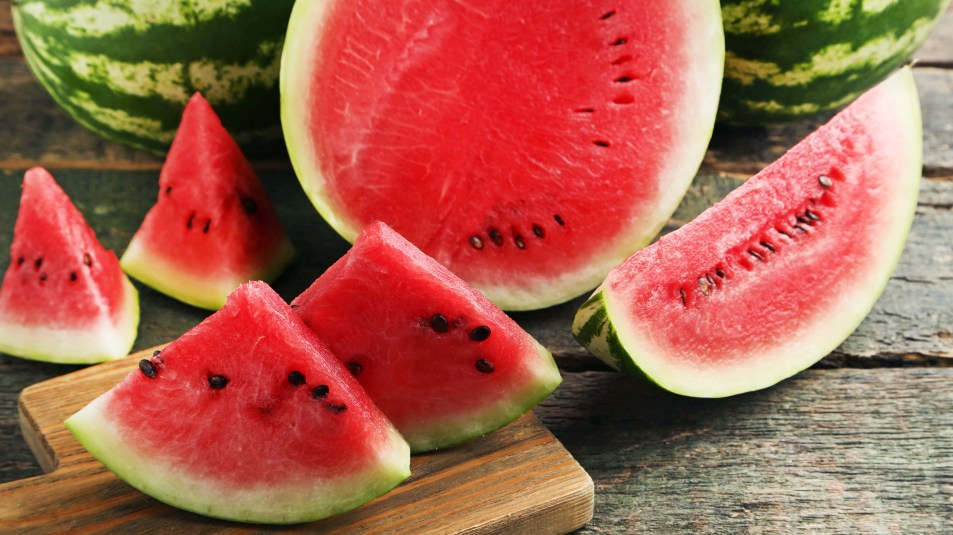Spitting Out Those Watermelon Seeds? Here’s Why and How to Nibble on Them Instead
They're packed with trace minerals and delicious roasted!

Watermelons are one of the most delicious summer snacks — they’re sweet and just so refreshing on a hot day. Making ‘em even better? All that juicy goodness is good for your health too! The fruit delivers a hefty dose of vitamins and nutrients all while being low in calories. And you’ll want to think twice before spitting at the seeds too, since they’re also packed with minerals that have a host of health benefits. Keep scrolling for how many calories are in watermelon—and the seeds!—and what both parts of the fruit can do for you.
How many calories are in watermelon?
According to the USDA, 2 cups of diced watermelon has 90 calories, 23 grams of carbohydrates, about 2 grams each of protein and fiber, plus just trace amoutns of fat. Why is watermelon so low in calories? Credit goes to its high water content — the fruit is almost 92 percent water.
How does watermelon keep you hydrated?
All that water doesn’t just keep the calories in watermelon low, it also quenches your thirst and keeps you hydrated, and it does so in a way that has lasting benefits beyond drinking a glass of regular old water. “Getting hydration from water-rich foods is the smartest strategy,” says integrative physician Dana Cohen, MD, coauthor of Quench. “The fiber in produce acts like a sponge, so we absorb the water more slowly and it stays in our system longer.”
What other nutrients are in watermelon?
Watermelon is high in vitamin A and vitamin C. Another nutrient that makes watermelon so good for you is lycopene. Lycopene is an antioxidant pigment that gives the fruit is pretty red hue — it also works as an anti-inflammatory. Studies found that it may help reduce blood pressure, and researchers are investigating its role in reducing cancer risk.
Can you eat watermelon seeds?
Yes! “It’s safe to eat watermelon seeds, and similar to pumpkin and sunflower seeds, they’re packed with nutrition,” say registered dietitian nutritionist Dawn Jackson Blatner, RDN, CSSD. According to the USDA, watermelon seeds are great sources of a wide range of trace minerals, including iron, phosphorous, copper and manganese, and one particularly beneficial non-trace minerals: magnesium.
The US Department of Health recommends that adult women get 320 grams of magnesium daily. It’s part of what turns food into energy and promotes muscle and nerve function. Magnesium is also great for lowering chronic inflammation, high blood pressure and easing anxiety or sleep problems. A small handful (or about one ounces) of watermelon seeds contains 146 milligrams of the nutrient—and contains only 23 calories!
What’s the best way to eat watermelon seeds?
Watermelon seeds can be eaten raw, but for the best flavor, Blatner recommends roasting them in a 325°F oven for about 15 minutes or until golden. “You can eat whole roasted watermelon seeds, and they will have a texture similar to pumpkin seeds,” she says. “Or you can remove the black outer shell with your teeth and just eat the inner whiter tender part, like you would eat sunflower seeds.”
One note of caution: “While the outer black shell is edible, it is hard, so it needs to be chewed well,” says Blatner, who adds that young kids and those with dental issues would be better off eating only the tender white parts.
Curious about eating the rind? You can eat that too! Click here for some fun ideas.
Should you buy organic watermelon?
If you want to avoid pesticides, buying organic produce can be a smart move. However, when it comes to watermelon, there’s no need to pay extra. That’s according to the Environmental Working Group, which recently released updated “Dirty Dozen” and “Clean Fifteen” lists that outline the levels of pesticides in foods. And watermelon made it to the Clean Fifteen list, meaning it’s safe to skip organic.
Easy watermelon recipes to try
Ready to get all the benefits from watermelon? Here are a few of our favorite recipes that make it deliciously easy:
Watermelon Fruit Pizza
Watermelon Berry Punch












